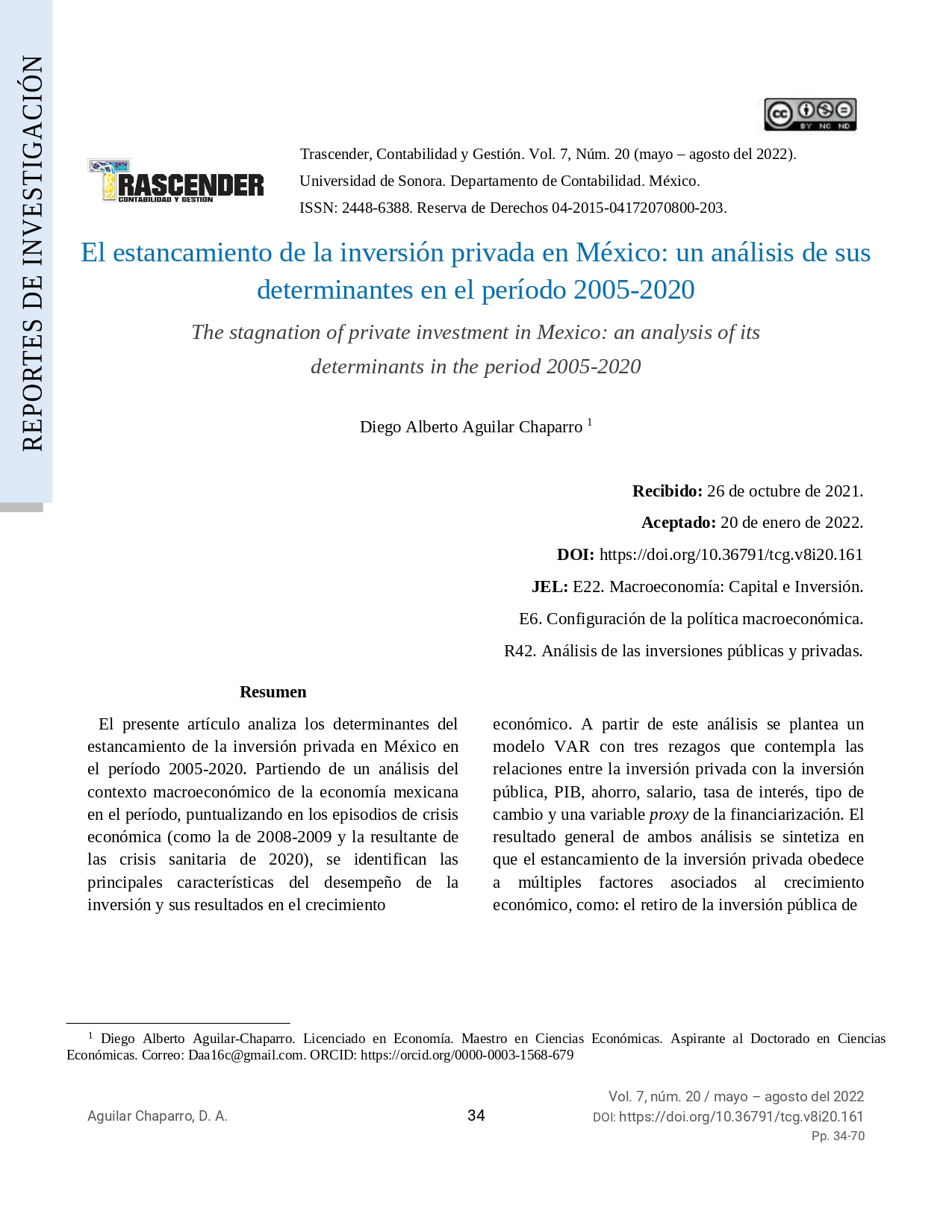The stagnation of private investment in Mexico: an analysis of its determinants in the period 2005-2020
DOI:
https://doi.org/10.36791/tcg.v8i20.161Keywords:
Private investment, economic growth, economic policy, VAR modelsAbstract
This article analyzes the determinants of the stagnation of private investment in Mexico in the period 2005-2020. Starting from an analysis of the macroeconomic context of the Mexican economy in the period, pointing out the episodes of economic crisis (such as the one in 2008-2009 and the one resulting from the health crisis), the main characteristics of investment performance and its effects are identified results in economic growth. Based on this analysis, a VAR model with three lags is proposed that considers the relationships between private investment and public investment, GDP, savings, salary, interest rate, exchange rate, and a proxy variable for financialization. The general result of both analyzes is synthesized in that the stagnation of private investment is due to multiple fields associated with economic growth, such as: the withdrawal of public investment from total investment, the appreciation of the exchange rate, the increase in the rate. of interest, the feedback of the falls in investment with those of the product and the stagnation of the low wages that the majority of the population perceives.
Downloads
References
Aroche, F. R. (2019). Estructura productiva y crecimiento económico en México: una perspectiva multisectorial. Investigaciones económicas, 78(309), 3-26. https://doi.org/10.22201/fe.01851667p.2019.309.70117 DOI: https://doi.org/10.22201/fe.01851667p.2019.309.70117
Bruno, M., Diawara, H., Araújo, E., Reis, A. C., y Rubens, M. (2011). “Finance-led growth regime no Brasil: estatuto teórico, evidencias empíricas e consequências macroeconômicas”. Revista de Economía Política, 31(5), 730-750.
https://doi.org/10.1590/S0101-31572011000500003 DOI: https://doi.org/10.1590/S0101-31572011000500003
Caballero, Ricardo J. (1999). Aggregate investment, Chapter 12, In Handbook of macroeconomics. USA, Ed. J.Taylor and M. Woodford., 814-84. DOI: https://doi.org/10.1016/S1574-0048(99)10020-X
Campos-Vázquez, Raymundo M., y Gerardo Esquivel. (2021). “Consumption and geographic mobility in pandemic times: Evidence from Mexico.” Review of Economics of the Household, 19, 353-371.
https://doi.org/10.1007/s11150-020-09539-2 DOI: https://doi.org/10.1007/s11150-020-09539-2
Castillo, R., y Herrera, J. (2005). “Efecto del gasto público sobre el gasto privado en México”, en Revista de Estudios Económicos, 20(2). https://doi.org/10.24201/ee.v20i2.164
Cobacho, M. B., Bosch, M., y Rodríguez, E. (2001). Efectos de la inversión pública federal en México, México.
Coen, R. M., y Eisner, R. (2018). Investment (Neoclassical). Palgrave Macmillan, The New Palgrave: A Dictionary of Economics. USA, Ed.3, 1,6950- 6959. DOI: https://doi.org/10.1057/978-1-349-95189-5_712
Cruz, G. F. S. (2017). El impacto del gasto público sobre la inversión privada en México (1980-2015). Economía UNAM,
(42), 136-149. https://doi.org/10.1016/j.eunam.2017.09.006 DOI: https://doi.org/10.1016/j.eunam.2017.09.006
Cruz, G. F. S., y Moreno Brid, J. C. (2018). Los determinantes de la inversión privada en México (1988-2015). Economía
Informa, Vol. 413, 4-15. http://www.economia.unam.mx/assets/pdfs/econinfo/413/01Losdeterminantesdelainversion.pdf Cuevas, V. (2001). ¿Debe la política cambiaria ser una competencia exclusiva del Banco de México? Una respuesta basada en el análisis empírico de la inflación”. Reforma del Estado, Políticas Públicas y Problemas Socioeconómicos del México
contemporáneo, Coord. Ramírez, J. y Maldonado, E. T, México, UAM-A, Biblioteca CSH. 201-239.
Elguézabal, A. P. L. (2004). Un modelo de pronósticos de la formación bruta de capital privada en México. Banco de México, No. 4. https://core.ac.uk/download/pdf/6278417.pdf
Epstein, G. A. (2005). “Introduction” on Financialization and the world economy” in Financialization and the world economy. Cheltenham, U.K. Edward Elgar.
Erden. L., y Holcombe, R. (2005). “The Effects of Public Investment on Private Investment in Developing Economies”. Public Finance Review, 33(5), 575-602. https://doi.org/10.1177/1091142105277627 DOI: https://doi.org/10.1177/1091142105277627
Granger, C. W. J., y Newbold, P. (1974). “Spurious regressions in econometrics”, Journal of Econometrics, 2(2), 111-120. https://doi.org/10.1016/0304-4076(74)90034-7 DOI: https://doi.org/10.1016/0304-4076(74)90034-7
Greene, W. H. (2003). Econometric Analysis. Prentice Hall. Hamilton, J. (1994). Time Series Analysis, Princeton, Princeton University Press. DOI: https://doi.org/10.1002/wilm.42820030622
Kalecki, M. (2007). Theory of Economic Dynamics.Routledge Taylor & Francis Group, London and Newyork. Kurihara, K. K. (1978). Introducción a la dinámica keynesiana. México: Fondo de Cultura Económica.
Kwiatkowski, D., Phillips, P. C. B, Schmidt, P., y Shin, Y. (1992). “Testing the null hypothesis of stationary against the alternative of a unit root”, Journal of Econometrics, 54(1-3), 159-178.
https://doi.org/10.1016/0304-4076(92)90104-Y DOI: https://doi.org/10.1016/0304-4076(92)90104-Y
Levy, N. O. (1993). “Determinantes de la inversión privada en México, 1960-1985”. Investigación Económica, 53(204), 143-177.
Loría, E. (2007). Econometría con Aplicaciones. México: Pearson Prentice Hall. MacKinnon, J. (1996). “Numerical distribution
functions for unit root and cointegration tests”. Journal of Applied Econometrics, 11(6), 601-618.
https://doi.org/10.1002/(SICI)1099-1255(199611)11:6<601::AID-JAE417>3.0.CO;2-T DOI: https://doi.org/10.1002/(SICI)1099-1255(199611)11:6<601::AID-JAE417>3.0.CO;2-T
Manuelito, S. y Jiménez, L. F. (2017). “Rasgos estilizados de la relación entre inversión y crecimiento en América Latina, 1980-2012”. Revista CEPAL, 115(42), 8-24. Recuperado de
https://repositorio.cepal.org/bitstream/handle/11362/37828/1/REV115Manuelito_es.pdf
Miranda, F. V, Ferrusca, K. A., y Gutiérrez, E. H.(2018). “Financiarización: la experiencia mexicana en el periodo 1993-2016”.
Análisis Económico, 34(85),33-52. https://doi.org/10.24275/uam/azc/dcsh/ae/2019v34n85 DOI: https://doi.org/10.24275/uam/azc/dcsh/ae/2019v34n85
Monroy-Gómez-Franco, L. (2021b). “¿Quién puede trabajar desde casa? evidencia desde México”. Estudios Económicos,
(1), 89-113. https://doi.org/10.24201/ee.v36i1.413 DOI: https://doi.org/10.24201/ee.v36i1.413
Moreno-Brid, J. C, Sandoval, J. K., y Valverde, I. (2016). “Tendencias y ciclos de la formación de capital fijo y la actividad productivas de la economía mexicana, 1960-2015”. Serie Estudio y Perspectivas, Núm. 170. Naciones Unidas, CEPAL.
https://repositorio.cepal.org/bitstream/handle/11362/40175/1/S1600493_es.pdf
Petri, F. (1997). “On Aggregate Investment as a Function of the Interest Rate”. Universita di Siena Working Paper, 217, 1-47.
http://dx.doi.org/10.2139/ssrn.199888 DOI: https://doi.org/10.2139/ssrn.199888
Ramírez, M. (1994). “Public and private investment in Mexico, 1950-90: an empirical analysis”, usa, Southern Economic Journal, 61(1), 1-17. https://doi.org/10.2307/1060126 DOI: https://doi.org/10.2307/1060126
Ramírez, M. (1991). “The impact of public investment on private capital formation: a study relating to Mexico”. Eastern
Economic Journal, 17(4), 425-437.https://ideas.repec.org/a/eej/eeconj/v17y1991i4p425-437.html
Ramírez, M. (2004). “Is public infrastructure investment productive in the Mexican case? A vector error correction analysis”, Journal of International Trade and Economic Development, 13(2), 159-178, https://doi.org/10.1080/0963819042000218700 DOI: https://doi.org/10.1080/0963819042000218700
Romer, D. (2012). Advanced macroeconomics. McGraw-Hill. Fourth-edition.
Ross, J. (2019). “Los retos de la política económica”.
Economía UNAM, 16(46), 16-23. https://doi.org/10.22201/fe.24488143e.2019.46.419
Secretaría de Hacienda y Crédito Público (SHCP). (2021). Balance Fiscal en México. Definición y Metodología.
https://www.secciones.hacienda.gob.mx/work/models/estadisticas_oportunas/metodologias/1bfm.pdf
Shaikh, A. (1974). “Laws of Production and Laws of Algebra: The Humbug Production Function”. Review of Economics and Statistics, 56(1), 115-118.https://doi.org/10.2307/1927538 DOI: https://doi.org/10.2307/1927538
Sims, C. A. (1980). “Macroeconomics and Reality,” Econometrica, 48(1), 1-48. https://doi.org/10.2307/1912017 DOI: https://doi.org/10.2307/1912017
Snowdon, B. y Vane, H. (2005). Modern Macroeconomics: Its Origins, Development and Current State. USA, Edward Elgar.
Wooldridge, J. (2010). Introducción a la econometría: un enfoque moderno. 4a. Edición Cengage Learning.

Downloads
Published
How to Cite
Issue
Section
License
Copyright (c) 2022 Diego Alberto Aguilar Chaparro

This work is licensed under a Creative Commons Attribution-NonCommercial-NoDerivatives 4.0 International License.
La Revista Trascender, Contabilidad y Gestión se compromete a asegurar la confidencialidad y privacidad dela información personal que se capture en éste sistema de conformidad con los lienamientos editoriales de la Universidad de Sonora
La información será utilizada únicamente para fines editoriales, académicos y de investigación, notificándose de forma directa al usuario registrado en el sistema, con el alcance que el usuario establezca al momento de su registro.
























